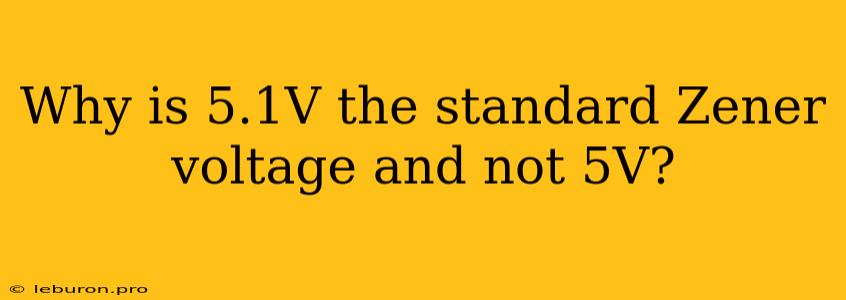Zener diodes, known for their ability to maintain a stable voltage across their terminals even when the current flowing through them varies, are widely used in voltage regulation circuits. While 5V is the standard voltage for many electronic devices, the commonly chosen Zener voltage for regulation is 5.1V, not 5V. This seemingly small difference is crucial for achieving efficient and reliable voltage regulation. This article will explore the reasons behind this seemingly peculiar choice, delving into the characteristics of Zener diodes, their role in voltage regulation, and the advantages of using 5.1V as the standard Zener voltage.
The Importance of Zener Diodes in Voltage Regulation
Zener diodes are semiconductor devices that exploit the Zener effect, a phenomenon where a strong electric field causes electrons to tunnel across the depletion region of the diode. This breakdown effect allows the diode to maintain a constant voltage across its terminals even when the current changes, acting like a voltage regulator.
How Zener Diodes Work
When the voltage across the Zener diode exceeds its breakdown voltage (the Zener voltage), the diode enters the Zener breakdown region. In this region, the voltage drop across the diode remains relatively constant, regardless of the current flowing through it. This characteristic makes Zener diodes ideal for stabilizing voltages in circuits.
Practical Applications of Zener Diodes
Zener diodes find applications in various electronic circuits, including:
-
Voltage Regulation: Zener diodes are commonly used as voltage regulators to maintain a stable output voltage even when the input voltage fluctuates. They are particularly useful in situations where a precise voltage level is required for sensitive components.
-
Reference Voltage Source: Zener diodes can provide a stable reference voltage for circuits where a specific voltage is needed for calibration or measurement purposes.
-
Overvoltage Protection: Zener diodes can act as overvoltage protection devices, diverting excess voltage to ground, preventing damage to sensitive components.
Why 5.1V and Not 5V?
While 5V is the standard voltage for many electronic devices, the choice of 5.1V as the standard Zener voltage is not arbitrary. It's a deliberate design decision rooted in the characteristics of Zener diodes and the efficiency of voltage regulation.
The Trade-Off Between Zener Voltage and Regulation Efficiency
The Zener voltage of a diode is the voltage at which it breaks down and starts conducting current. This breakdown voltage is not an exact value; it has a small tolerance range. The choice of 5.1V instead of 5V is motivated by the fact that it allows for a more efficient voltage regulation.
-
Minimizing Power Dissipation: When the input voltage fluctuates, the Zener diode dissipates the excess power as heat. Choosing a Zener voltage slightly higher than the desired output voltage allows the diode to operate in a less stressful region, minimizing power dissipation and reducing the risk of overheating.
-
Maximizing Zener Diode Efficiency: A Zener diode is most efficient when operating within its specified voltage range. Choosing 5.1V allows the diode to operate within this range for a broader range of input voltage fluctuations, maximizing its efficiency.
-
Accounting for Tolerance: Zener diodes are not perfectly precise. They have a tolerance range, meaning the actual breakdown voltage can vary slightly from the specified value. Using 5.1V instead of 5V accounts for this tolerance, ensuring that the regulated output voltage stays within an acceptable range.
Choosing the Right Zener Voltage
The choice of the Zener voltage is crucial for ensuring the proper operation of a voltage regulator. The ideal Zener voltage should:
-
Be slightly higher than the desired output voltage to minimize power dissipation and maximize efficiency.
-
Account for the tolerance of the Zener diode to ensure stable voltage regulation.
-
Consider the voltage fluctuations of the input supply to maintain a consistent output voltage.
Conclusion
The choice of 5.1V as the standard Zener voltage over 5V is not arbitrary. It's a strategic design decision based on the characteristics of Zener diodes and the efficiency of voltage regulation. By using 5.1V, we can effectively mitigate power dissipation, maximize the efficiency of the Zener diode, and account for the tolerances of the devices. This seemingly small difference in voltage plays a crucial role in ensuring the reliability and efficiency of voltage regulation circuits.
